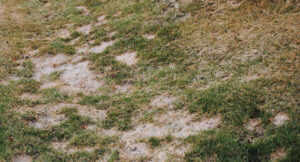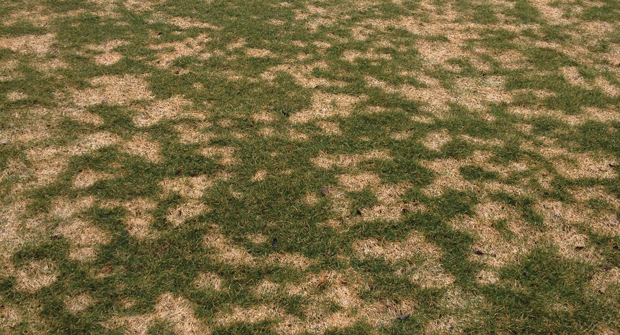Snow mold is a turfgrass disease that thrives in cool to cold weather. It poses significant concerns for lawn care operators (LCOs), particularly in regions experiencing heavy snowfall and prolonged winter conditions.
Understanding the causes, symptoms and preventive measures for snow mold is crucial for maintaining a healthy and aesthetically pleasing lawn.
Identification
Snow mold is a fungal disease that manifests as unsightly patches of dead grass and can wreak havoc on lawns if not properly managed. Paul Koch, Ph.D., a plant pathologist at the University of Wisconsin, explains that the fungus grows under snow cover, and the damage becomes apparent once the snow melts. This damage appears as circular patches of dead or matted grass, ranging from a few inches to several feet in diameter.

There are three primary types of snow mold: gray, speckled and pink. Gray and speckled snow molds (collectively referred to as gray snow mold), caused by Typhula species of fungi, have sclerotia that allow the fungal disease to spread and form gray or white circular patches in turfgrass. Pink snow mold, caused by Microdochium species of fungi, doesn’t always require snow cover to form and creates pinkish circular patches.
Certain turfgrass species, such as tall fescue and perennial ryegrass, are more susceptible to snow mold, while others, like Kentucky bluegrass and fine fescues, are more tolerant.
Koch advises against using fungicides for snow mold control in lawns, as they generally recover on their own, although recovery may sometimes take a while. However, effective snow mold products that can be used on lawns exist within the strobilurin and demethylation inhibitor classes of fungicides.
Prevention
Pink snow mold is more common in southern states and the Pacific Northwest and does not require snow cover to occur, unlike gray snow molds which do. Lisa Beirn, Ph.D., technical service manager for Syngenta, advises keeping an eye out for snow mold in areas with snow cover or during prolonged rainy and overcast periods in the spring.
“LCOs must stay on top of their maintenance programs by limiting fertilizer applications and continuing to mow late into the fall to avoid promoting excessive grass growth. Tall grass at the time of snowfall provides a conducive environment for snow mold,” she says.
When using fungicides for snow mold management, applications in late October to early November prior to snow cover provide good control. For pink mold, fungicide applications within the same time frame, even when there is no snow, can provide good control.
Many fungicides are labeled for snow mold control, and LCOs must read product labels carefully. It is recommended to use tank mixes of different active ingredients or fungicides with multiple active ingredients to combat the various species that cause snow mold.
Staying ahead
Zac Reicher, Ph.D., a specialist with the Envu Green Solutions Team, states that snow mold is generally not a big issue on home lawns except after a hard winter. In spring, snow mold is usually associated with areas where snow has been piled up for a long time. When the snow melts, it leaves circular patches that don’t green up.
“Preventing a conducive environment for snow mold is the first line of defense,” he says. “This includes continuing to mow at a 3-inch height until the grass stops growing and ceasing fertilizer applications in late fall. Removing tree leaves before winter also helps, as they can create an environment for snow mold.”
Reicher adds that snow mold rarely causes turfgrass death, and infected areas will eventually recover. Raking infected areas to remove dead grass will allow turfgrass to regrow and recover. However, fungicides may be used in areas with heavy snowfall, such as mountain towns and the Northeast, or in instances where high-value turf is present.


